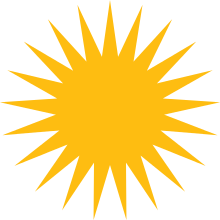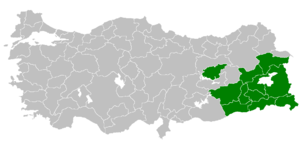Turkish Kurdistan
Turkish Kurdistan or Northern Kurdistan (Kurdish: Bakurê Kurdistanê or Kurdistana Tirkiyê) refers to portions of Turkey's Eastern Anatolia Region and Southeastern Anatolia Region where Kurds form the predominant ethnic group. This unofficial term references the region's geographical and historical location with respect to the larger Kurdish region. Historically, its northern area was part of Greater Armenia, but after centuries of inward migration by Kurdish tribes and because of the Armenian Genocide during World War One, very few Armenians now live in the area.[2]
Kurds generally consider southeastern Turkey to be one of the four parts of a Greater Kurdistan, which also includes parts of northern Syria (Rojava or Western Kurdistan), northern Iraq (Southern Kurdistan), and northwestern Iran (Eastern Kurdistan).[3]
| Part of a series on Kurdish history and Kurdish culture |
 |
|
Geography and economy

In the census of 1965, Kurdish-speakers made up the majority in Ağrı, Batman, Muş, Bingöl, Tunceli, Bitlis, Mardin, Şanlıurfa, Hakkâri, Siirt, Şırnak, and Van, and the plurality in Diyarbakır.[4][5]
According to Encyclopædia Britannica there are 13 Kurdish majority provinces of Turkey: Iğdır, Tunceli, Bingöl, Muş, Ağrı, Adıyaman, Diyarbakır, Siirt, Bitlis, Van, Şanlıurfa, Mardin, and Hakkâri.[6]
In 1987, the Encyclopaedia of Islam described Turkish Kurdistan, historically, as covering at least 17 provinces of Turkey: Adıyaman, Ağrı, Bingöl, Bitlis, Diyarbakır, Elazığ, Erzincan, Erzurum, Hakkâri, Kars, Malatya, Mardin, Muş, Siirt, Şanlıurfa, Tunceli and Van. The Encyclopaedia of Islam stresses at the same time that "the imprecise limits of the frontiers of Kurdistan hardly allow an exact appreciation of the area."[7] Since 1987, four new provinces - Şırnak, Batman, Iğdır and Ardahan - have been created inside the Turkish administrative system out of the territory of some of these provinces.
The region has no unified administrative identity and the Turkish state rejects the use of the term "Kurdistan" to describe it. In addition to the provinces already mentioned, the region forms part of the wider geographic subdivisions of Southeastern Anatolia Region (Güneydoğu Anadolu Bölgesi) and Eastern Anatolia Region (Doğu Anadolu Bölgesi).
The region forms the south-eastern edge of Anatolia. It is dominated by high peaks rising to over 3,700m (12,000 ft) and arid mountain plateaux, forming part of the arc of the Taurus Mountains. It has an extreme continental climate — hot in the summer, bitterly cold in the winter. Despite this, much of the region is fertile and has traditionally exported grain and livestock to the cities in the plains. The local economy is dominated by animal husbandry and small-scale agriculture, with cross-border smuggling (especially of petroleum) providing a major source of income in the border areas. Larger-scale agriculture and industrial activities dominate the economic life of the lower-lying region around Diyarbakır, the largest Kurdish-populated city in the region. Elsewhere, however, decades of conflict and high unemployment has led to extensive migration from the region to other parts of Turkey and abroad.[8]
History

.svg.png)
| Region | Region (Turkish name) | % Kurdish |
|---|---|---|
| Central East Anatolia | Ortadoğu Anadolu | 79.1% |
| Southeast Anatolia | Güneydoğu Anadolu | 64.1% |
| Northeast Anatolia | Kuzeydoğu Anadolu | 32.0% |
| Istanbul | Istanbul | 14.8% |
| Western Anatolia | Bati Anadolu | 7.7% |
| Aegean | Ege | 6.1% |
| Mediterranean | Akdeniz | 4.9% |
| East Marmara | Doğu Marmara | 4.9% |
| Central Anatolia | Orta Anadolu | 1.3% |
| West Marmara | Bati Marmara | 0.9% |
| West Black Sea | Bati Karadeniz | 0.3% |
| East Black Sea | Doğu Karadeniz | 0.1% |
During the Middle Ages, the Kurdish-inhabited regions of the Middle East came under the rule of local Kurdish chieftains, though they never established an unified nation state. During 10th and 11th centuries, the region was ruled by the Kurdish dynasty of Marwanid. From the 14th century onwards the region was mostly incorporated into the Ottoman Empire.
Kurdish principalities of the region
A tax register (or defter) dating back to 1527, mentions an area called vilayet-i Kurdistan, which included 7 major and 11 minor emirates (or principalities). The document refers to Kurdish emirates as eyalet(state), an indication of the autonomy enjoyed by these principalities. In a ferman (imperial decree) issued by Suleiman I, around 1533, he outlines the rules of inheritance and succession among Kurdistan beys i.e. Kurdish nobility. Hereditary succession was granted to Kurdish emirates loyal to the Ottomans, and Kurdish princes were granted autonomy within the Empire. The degree of autonomy of these emirates varied greatly and depended on their geo-political significance. The weak Kurdish tribes were forced to join stronger ones or become a part of Ottoman sancaks (or sanjak). However the powerful and less accessible tribes, particularly those close to the Iranian border, enjoyed high degrees of autonomy. According to a kanunname(book of law) mentioned by Evliya Çelebi, there were two adiministrative units different from regular sanjaks: 1) Kurdish sancaks (Ekrad Beyliği), characterized by hereditary rule of the Kurdish nobility and 2) Kurdish governments (hükümet). The Kurdish sanjaks like ordinary sanjaks, had some military obligations and had to pay some taxes. On the other hand, the Kurdish hükümet neither pay taxes nor provided troops for the Ottoman Army. The Ottomans preferred not to interfere in their succession and internal affairs. As Evliya Çelebi has reported, by the mid-17th century the autonomy of Kurdish emirates had diminished. At his time, out of 19 sancaks of Diyarbakir, 12 were regular Ottoman sanjaks, and the remaining were referred to as Kurdish sanjaks. Kurdish sanjaks were reported as Sagman, Kulp, Mihraniye, Tercil, Atak, Pertek, Çapakçur and Çermik. He also reported the Kurdish states or hükümets as Cezire, Egil, Genç, Palu and Hazo. In the late 18th and early 19th century, with the decline of Ottoman Empire, the Kurdish principalities became practically independent.[9]
Modern history

The Ottoman government began to assert its authority in the region in the early 19th century. Concerned with independent-mindedness of Kurdish principalities, Ottomans sought to curb their influence and bring them under the control of central government in Istanbul. However, removal from power of these hereditary principalities, led to more instability in the region from the 1840s onwards. In their place, sufi sheiks and religious orders rose to prominence and spread their influence throughout the region. One of the prominent Sufi leaders was Shaikh Ubaidalla Nahri, who began a revolt in the region between Lakes Van and Urmia. The area under his control covered both Ottoman and Qajar territories. Shaikh Ubaidalla is regarded as one of the earliest leaders who pursued modern nationalist ideas among Kurds. In a letter to a British Vice-Consul, he declared: the Kurdish nation is a people apart . . . we want our affairs to be in our hands'.'[10]
The breakup of the Ottoman Empire after its defeat in the First World War led to its dismemberment and establishment of the present-day political boundaries, dividing the Kurdish-inhabited regions between several newly created states. The establishment and enforcement of the new borders had profound effects for the Kurds, who had to abandon their traditional nomadism for village life and settled farming.[11]
Conflict and controversy
| Part of a series on the Kurdish–Turkish conflict | ||||
| Kurdish–Turkish peace process | ||||
|---|---|---|---|---|
.png) | ||||
|
History
|
||||
|
Primary concerns |
||||
|
International brokers |
||||
|
Proposals |
||||
The incorporation into Turkey of the Kurdish-inhabited regions of eastern Anatolia was opposed by many Kurds, and has resulted in a long-running separatist conflict in which thousands of lives have been lost. The region saw several major Kurdish rebellions during the 1920s and 1930s. These were forcefully put down by the Turkish authorities and the region was declared a closed military area from which foreigners were banned between 1925 and 1965. The use of Kurdish language was outlawed, the words Kurds and Kurdistan were erased from dictionaries and history books, and the Kurds were only referred to as Mountain Turks.[12]
In 1983, a number of provinces were placed under martial law in response to the activities of the militant separatist Kurdistan Workers Party (PKK).[13] A guerrilla war took place through the rest of the 1980s and into the 1990s. By 1993, the total number of security forces involved in the struggle in southeastern Turkey was about 200,000, and the conflict had become the largest counter-insurgency in the Middle East,[14] in which much of the countryside was evacuated, thousands of Kurdish-populated villages were destroyed, and numerous extra judicial summary executions were carried out by both sides.[8] More than 37,000 people were killed in the violence and hundreds of thousands more were forced to leave their homes.[15] The situation in the region has since eased following the capture of the PKK leader Abdullah Öcalan in 1999 and the introduction of a greater degree of official tolerance for Kurdish cultural activities, encouraged by the European Union.[11] However, some political violence is still ongoing and the Turkish-Iraqi border region remains tense.[16]
Ethnic groups
Turkish Kurdistan is inhabited predominantly by ethnic Kurds, with Turkish, Arab, Zaza, and Assyrian minorities.[4][5]
1965 Census
| Mother tongue[4] | Populationa | Percentage |
|---|---|---|
| Kurdish | 1,149,166 | 60.8% |
| Turkish | 535,880 | 28.4% |
| Arabic | 124,586 | 6.6% |
| Zazaki | 60,326 | 3.2% |
| Other | 19,965 | 1.1% |
| Total | 1,889,923 | 100% |
- Notes
- ^a The source is the Turkish 1965 census. The provinces included are: Ağrı, Bitlis, Diyarbakır, Hakkari, Mardin, Siirt (including Batman and Şırnak) and Van.[4]
See also
- Iranian Kurdistan
- Iraqi Kurdistan
- Syrian Kurdistan
- Kurdish people
- Kurds in Syria
- Kurdification
- Turkification
References
- ↑ http://www.foia.cia.gov/sites/default/files/document_conversions/89801/DOC_0000258376.pdf, (2015), by Central Intelligence Agency Website
- ↑ http://www.hips.hacettepe.edu.tr/nbd_cilt25/mutlu.pdf
- ↑ Kurdish Awakening: Nation Building in a Fragmented Homeland, (2014), by Ofra Bengio, University of Texas Press
- 1 2 3 4 5 Heinz Kloss & Grant McConnel, Linguistic composition of the nations of the world, vol,5, Europe and USSR, Québec, Presses de l'Université Laval, 1984, ISBN 2-7637-7044-4
- 1 2 3 Ahmet Buran Ph.D., Türkiye'de Diller ve Etnik Gruplar, 2012
- ↑ http://global.britannica.com/place/Kurdistan
- ↑ Khanam, R. (2005). Encyclopaedic Ethnography of Middle-East and Central Asia. A-I, V. 1. Global Vision Publishing House. p. 470. ISBN 9788182200623.
- 1 2 van Bruinessen, Martin. "Kurdistan." Oxford Companion to the Politics of the World, 2nd edition. Joel Krieger, ed. Oxford University Press, 2001.
- ↑ Ozoglu, Hakan. State-Tribe Relations: Kurdish Tribalism in the 16th- and 17th- Century Ottoman Empire, pp.15,18–22,26, British Journal of Middle Eastern Studies, 1996
- ↑ Dahlman, Carl. The Political Geography of Kurdistan, Eurasian Geography and Economics, Vol. 43, No. 4, 2002, p.278
- 1 2 "Kurd," Encyclopædia Britannica. Ultimate Reference Suite. Chicago: Encyclopædia Britannica, 2007.
- ↑ G. Chaliand, A.R. Ghassemlou, M. Pallis, A People Without A Country, 256 pp., Zed Books, 1992, ISBN 1-85649-194-3, p.58
- ↑ "Kurd," Hutchinson Unabridged Encyclopedia including Atlas, 2005.
- ↑ "Turkey," Encyclopædia Britannica. Ultimate Reference Suite. Chicago: Encyclopædia Britannica, 2007.
- ↑ "Kurdish rebels kill Turkey troops", BBC News, 8 May 2007.
- ↑ "Turkish soldiers killed in blast", BBC News, 24 May 2007.
External links
- Maps of Kurdish Regions by GlobalSecurity.org
- Map of Kurdish Population Distribution by GlobalSecurity.org

.jpg)